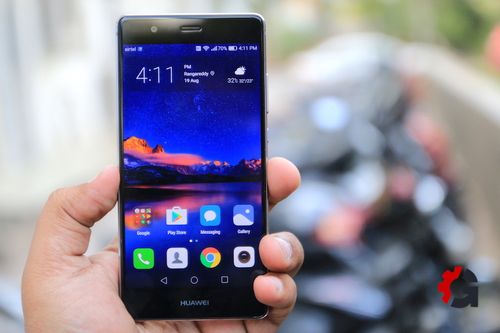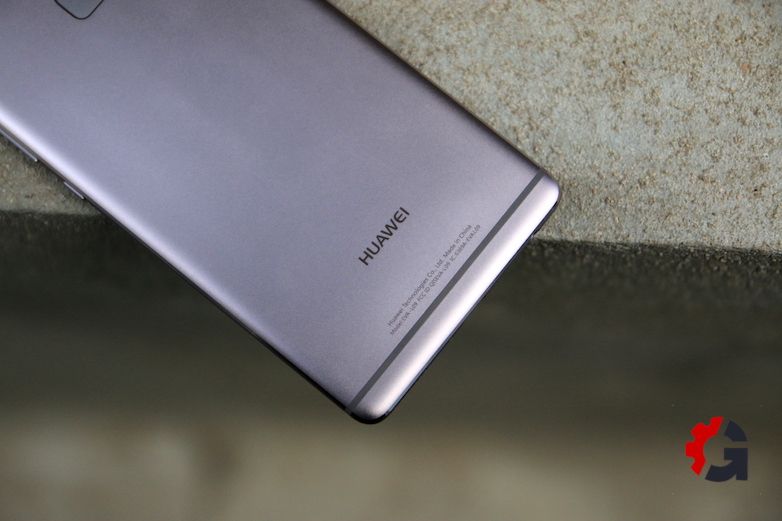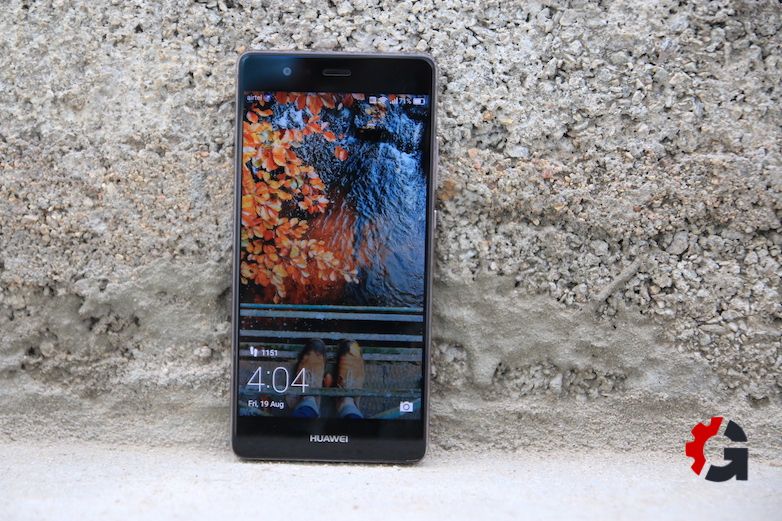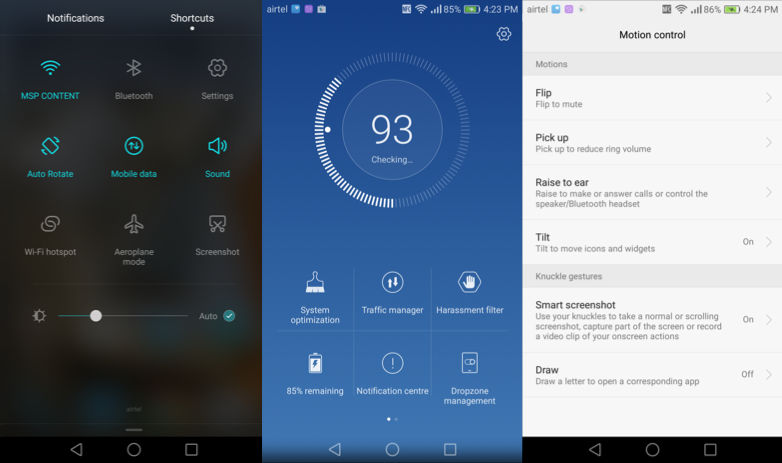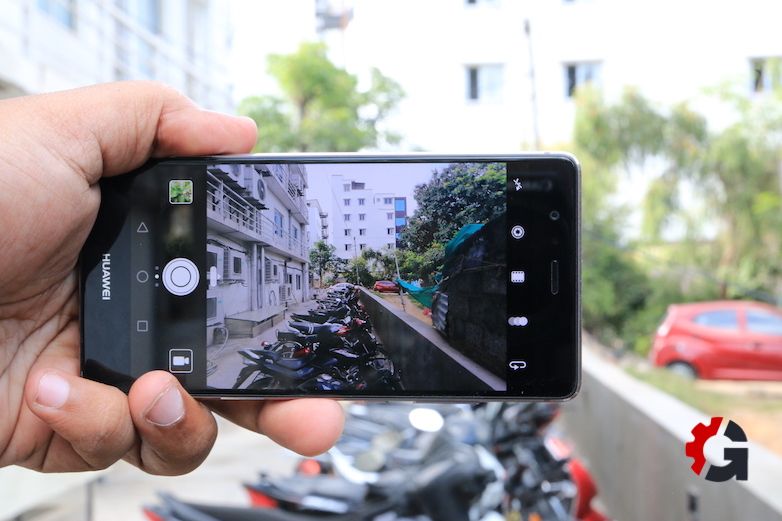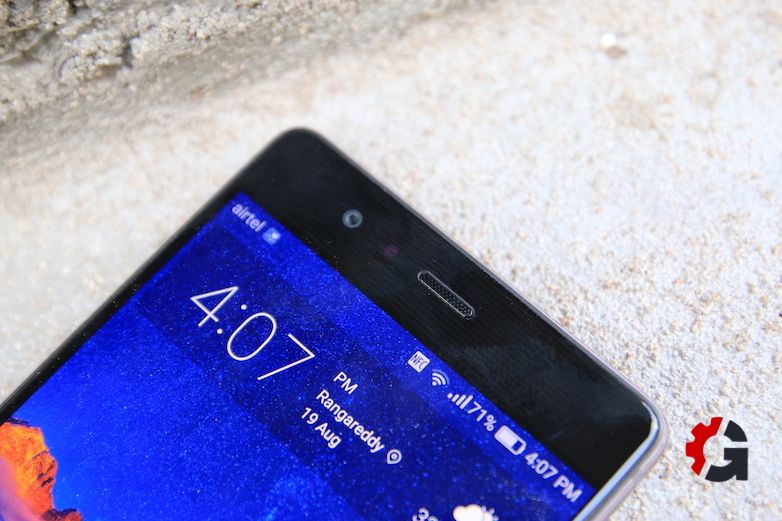
Smartphone cameras have become such a force to reckon with that recommending a standalone budget compact digital camera (ones with a 1/2.3-inch image sensor) seems almost pointless now. Flagship smartphones like the Samsung Galaxy S7, LG G5, Apple iPhone 6s, and the HTC 10 can take some really impressive pictures that are on par with digital cameras. In fact, our camera expert George found that there is practically little that differentiates the cameras inside the Samsung Galaxy S7, LG G5, and HTC 10. They are all indeed very good.
Entering the fray is Chinese smartphone brand Huawei’s latest flagship – the Huawei P9. Incidentally, this is also the first time that Huawei is bringing its P series smartphone to India. The P9’s major attraction is the fact that it has dual cameras. However, dual camera technology is not an entirely new concept and other manufacturers have had smartphones with two camera lenses before the Huawei P9 too. Of course, the second camera sensor would be used for different functions by different manufacturers.
For example, the second camera on the LG G5 is used for capturing a wider angle. Similarly, HTC had its own interpretation of a dual camera on its older HTC One (M8), wherein a secondary camera was used to capture depth information. Furthermore, it is being widely rumoured that the Apple iPhone 7 will include dual cameras, which could indicate that the future of mobile phone photography is to include two camera units instead of one.
The Leica branding by itself is enough to make camera enthusiasts sit up and take notice.
What sets the dual cameras on the Huawei P9 apart is the fact that Huawei has reportedly ‘co-engineered’ it with Leica – a German camera and optics manufacturer with a massive legacy. The Leica branding by itself is enough to make camera enthusiasts sit up and take notice, but what does ‘co-engineered’ mean in terms of the camera performance? Is it merely a marketing gimmick? I try to find that out and more about the Huawei P9, which could very well be a camera masquerading as a smartphone.
Huawei P9 design: A handsome slab of metal
Huawei’s Nexus 6P is a phone that stands out thanks to its impressive design. With the P9, Huawei has leveraged upon the impressive design of the Nexus 6P to create a smartphone that is not only smaller, but also a lot more ergonomic. The P9 is not the slimmest (6.95mm) or the lightest (162g) phone around, but its overall construction feels very cohesive. The P9 can be used with a single hand, even if you don’t have large hands. This is also possible due to the fact that it is only 75.3mm wide, with really narrow 1.4mm bezels on either sides of the display.
The Huawei P9 is made entirely of aerospace-grade aluminium with chamfered edges and rounded corners. This unibody chunk of metal is solidly built and feels extremely sturdy; it can definitely sustain a fall or two. Also, unlike other smartphones with metal bodies, the P9 doesn’t feel slippery at all. What’s even more impressive is that Huawei has managed to cram two camera lenses inside the slim body of the P9 without any ugly camera bump.
Talking about the cameras, the P9 has a glass band visor on top of the rear that houses them. Flanking the cameras to their right are the dual-LED (dual tone) flash and the laser autofocus module stacked on top of each other. The glass band also mentions the Leica branding. Do note that the glass is susceptible to scratches, so you should be a bit conscious about it while handling the phone. The fingerprint scanner that sits right below the glass band is easy to reach.
There are two plastic antenna bands running along the top and the bottom half of the phone. The bands don’t look too shabby on our Titanium Grey review unit though. The P9 is also available in Prestige Gold and Mystic Silver colours. The power button and the volume rocker are easily accessible on the right edge. These buttons are made of metal and provide good tactile feedback. Also, the power button has ridges on it that easily distinguishes it from the volume rocker.
I can’t help but notice the lack of a dedicated camera button on a phone that claims to reinvent smartphone photography, which feels like a missed opportunity. The left edge has the tray which accepts a Nano SIM card and a microSD card. A single microphone for capturing audio during video capture is present on the top edge. Above the display, you can find the earpiece and the front-facing camera.
The minor design faux pas not withstanding, the Huawei P9 is one of the best-designed smartphones released this year.
Coming to the bottom edge, you will find the new USB Type-C port, a single mono loudspeaker, and a headphone port. If you are anything like me, who can get annoyed by minor inconsistencies then you will notice that the 3.5mm audio port’s slot is misaligned and cuts through the chamfered edge at the lower part of the bottom edge. Attention to minor details like these is what sets apart brands like Apple and Samsung.

All said and done, the minor design faux pas not withstanding, the Huawei P9 is one of the best-designed smartphones released this year.
Huawei P9 display: Crisp and bright
The Huawei P9 has a 5.2-inch IPS Neo LCD display, which outputs a resolution of 1080x1920p (FHD). While most flagships these days come with a QHD (1440x2560p) panel, the difference in resolution is not immediately apparent, especially on a smaller screen. Moreover, the real advantage of having a QHD becomes obvious while consuming mobile virtual reality (VR) content, which still has a long way to go before it becomes mainstream.
Coming to the quality of the display panel used on the Huawei P9, it is pretty competent. With a screen density of 441 PPI, images and text look crisp. Colours have the right amount of pop and if you don’t like the default colour temperature of the display, you can change that from the settings. The viewing angles are pretty good. The display can also get bright enough to be perfectly legible in direct sunlight.
Huawei P9 software: EMUI+Marshmallow is clean but looks cartoonish
The Huawei P9 runs a custom fork of Android 6.0 Marshmallow called Emotion UI, version 4.1. EMUI is starkly different from vanilla Android and does away with the app drawer. All the apps are lined up on the home screen. The icons have rounded edges, which look childish and don’t go well with the premium exterior of the phone.If the P9 were a man, it’d be one who has a Greek God physique but a bad dressing sense. However, clothes do not maketh a man and can be changed if needed.
Similarly, I am not going to fault the icon design of EMUI because you can swap them very easily. Or, if you want to change the entire look of EMUI — maybe even bring back the app drawer — you could very easily install an launcher. During my time with the device I alternated between the Nokia’s Z-launcher and the Google Now launcher.
If the P9 were a man, it’d be one who has a Greek God physique but a bad dressing sense.
The P9 also provides you with an option to change themes on EMUI. I applied a few during testing and found them to be rather interesting. Most of them were over-the-top visually, no doubt, but they had a clean look and didn’t look tacky like the ones in Xiaomi’s theme store. For the lock screen, EMUI has something called a Magazine Cover that essentially changes the wallpaper each time you wake the device up from sleep state. By swiping up from the bottom of the lock, you fiddle around with the wallpapers you’d like to see on Magazine Cover and also get instant access to system apps like camera, torch, sound recorder, and calculator.
EMUI also includes some nifty software tweaks like one-handed UI, where it shrinks the screen to one side of the P9. Similarly, you can also change the navigation bar of capacitive buttons to your liking, flip the phone to mute a call or raise it to your ear to pick a call, and draw an alphabet to open an app assigned to it. While I didn’t use all of them, I think it is good to have these options.
Now, one of the problems I have with the device’s software is that apart from your general suite of Google apps and Huawei’s homegrown apps, the P9 also includes bloatware aplenty. A ton of Gameloft games and a few social networking apps are pre-installed on the phone. Thankfully, most of them can be uninstalled, which is good.
Huawei P9 performance: The Kirin 955 is impressive save for the heating issues
Huawei uses its homegrown octa-core HiSilicon Kirin 955 SoC. This SoC uses four 2.5GHz Cortex A72 chips and four 1.8GHz Cortex A53 chips, apart from Mali-T880 MP4. The phone also has 3GB of RAM and 32GB of internal storage space, with the capacity to accept a microSD card up to 256GB in capacity. Now, these are all impressive specs and while the Kirin 955 SoC is no Qualcomm Snapdragon 820, it definitely gets the job done.
In daily usage, I never faced a single slowdown — apps opened fairly quickly and the scrolling speed in web pages was pretty good too. But, there is a small problem though. Out of the 3GB of RAM, at any given point only around 1.5GB is available for apps, and the rest is taken up by system services, which is a bit much. Moving past that, the P9 plays graphically intensive games without any lags. I tested Modern Combat 5 and Asphalt 8 with the P9, and both ran just fine. However, in comparison games run noticeably smoother on devices like the Samsung Galaxy S7 and the iPhone 6s.
The fingerprint scanner on the P9 is an absolute treat to use. It recognises the fingerprint much faster than the ones on many phones out there and dare I say, even faster than the iPhone 6s. Huawei’s fingerprint scanning technology is really impressive and the fact that it can read your fingerprint in 360-degrees is a value addition. What’s more, you can also configure the fingerprint reader to open the notifications slider by swiping on it from top to bottom. You can also use it to swipe between images when browsing the gallery.
The mono speaker on the P9 is a bit underwhelming and since it is placed at the bottom, it obstructs sound while watching videos in landscape orientation. Thankfully, the quality of sound through earphones is really impressive and the bundled earphones are not bad either. The phone can play all the videos you throw at it without giving you much reason to complain about.
The phone heats up when performing CPU intensive tasks but it happens ever so rarely that it doesn’t really hamper the experience of using the phone.
The sound quality in calls is as good as on any Motorola phone, which is saying that it is pretty good. Also, I didn’t notice a single call drop even in areas of high congestion. I used an Airtel 4G SIM card with the P9 in Hyderabad and Delhi, and had constant 4G connectivity throughout my review period. Another interesting addition to the P9 is the Wi-Fi+ mode that essentially works as a smart network switching system.
My review unit of P9 had automatically learnt all the access points I used regularly, mostly at work and home, and used to connect and disconnect from them automatically. This is truly a feature worthy of a phone that is meant to be smart. Moreover, I am not surprised that it comes from a Huawei device because the company is quite a biggie in the world of networking for enterprises.
Well, if my experience with the P9 isn’t enough to convince you, the phone did well in our benchmark tests too. AnTuTu benchmark returned a score of 95,181, which is not in the same league as the Snapdragon 820 phones, but it is respectable. Additionally, in GFXBench the phone managed to log 33fps, which is pretty decent. However, do note that the phone heats up when performing CPU intensive tasks but it happens ever so rarely that it doesn’t really hamper the experience of using the phone.
Huawei P9 camera: Say “cheese” or “Leica”
The part you’ve all been waiting for, the camera. Before I get into the nitty-gritty of this feature, let us take a look at the hardware on offer. On the rear are two 12-megapixel Sony IMX286 sensors, 1.25µm pixels in size each. One of the sensors captures the entire RGB spectrum and the other shoots only monochrome. What this means, in theory, is that the monochrome sensor can let in more light and capture more detail. Attached to the two sensors are a pair of Leica Summarit H 1:2.2/27 lenses with F2.2 aperture. On the other side, the front camera has an 8-megapixel sensor coupled with an F2.4 lens.
The camera app has an easy-to-use layout and iconography that is inspired by Leica’s cameras. I especially like the little handle icon that sits right above the shutter button. This handle can be used to invoke the Professional shooting mode in a jiffy. The app also provides a bevy of shooting modes like Monochrome, Beauty, HDR, Night Shot, Panorama, and Light Painting. Additionally, a Wide Aperture mode makes use of both the cameras and the in-built software to capture images with more depth. There are a ton of filters and colour options as well. My only grouse with an otherwise wonderfully laid out camera app is the fact that the Settings menu invoked by sliding from right to left can only be viewed in portrait orientation.
The two 12-megapixel cameras in tandem can capture images in daylight with great contrast and impressive details in shadows and highlights.
Coming to the performance, the two 12-megapixel cameras in tandem can capture images in daylight with great contrast and impressive details in shadows and highlights. However, the colour reproduction was a bit too saturated for my taste. It looks like Huawei has done this to please the general crowd. Thankfully, you can tone down the saturation in the app. Now, the other thing that I noticed is that details are a bit soft around the edges of the photo. The software post processing tends to be in favour of softening the details to kill the grains in daylight shots.
That said, I haven’t seen such impressive handling of the dynamic range in an image using just the auto mode of any smartphone camera in the past. In fact, switching to the HDR mode on the P9 actually caused some highlights to blow out. Thankfully, there was little to no chromatic aberration. I did notice a slight barrel distortion when shooting wide-angle landscape shots, though.
I had fun using the Wide Aperture mode which can be used to create a nice bokeh around the subject, albeit software generated. The sense of depth created in this mode is exceptionally good and no smartphone camera has come even close to the P9’s software processing to simulate this effect. Having said that, don’t go overboard with this mode, such as going all the way to F0.9, because, most of the times, the subject ends up looking funny. The other mode that returns great shots is the Monochrome mode, and it is all thanks to the increased level of detail and high saturation that the P9 captures. If you have the patience, you can capture some incredibly professional-looking monochrome shots even in low light. I suggest switching on the grid in the app to use the one-third rule of photography to frame your shots.
If you have the patience, you can capture some incredibly professional-looking monochrome shots even in low light.
In low light, the camera does capture an ample amount of light, but the lack of OIS means that focussing is a major hassle. More often than not, I ended up capturing blurry shots. The camera’s software tends to crank up the ISO to ISO 1000 and also use a slower shutter speed, which only makes matters worse. There is visible grain in low light images. Ideally, you should use the Professional mode, which will provide you more control, put the P9 on a tripod, and the the results will be worth showcasing.
The lack of OIS also means that you will invariably end up with shaky videos. You can capture videos with a maximum resolution of 1080p at 60fps. Thanks to the use of a great sensor and lens, the details in videos are also pretty good. Corners seem underexposed at times but it is just that the camera manages to bring out the details in shadows with relative ease when compared to other smartphone cameras. Another major issue with the video recording is that the sound capture using the in-built mic is really bad – even wind noise is captured very easily. The front 8-megapixel camera captures a lot of details and the selfies are probably the best I’ve seen on any smartphone.
Looking past all the technical mumbo jumbo, if you have a steady pair of hands, the photos captured by the Huawei P9’s rear camera will shock you at times. In comparison with the Galaxy S7, the LG G5, and the iPhone 6s, the Huawei P9’s camera is just a few tricks short of ‘on par’.
Huawei P9 battery: Lasts a day on moderate usage
The Huawei P9 houses a 3,000mAh battery inside its slim 6.95mm body, which is an impressive feat in itself. It also supports fast charging and Huawei claims it can charge from zero to 44 percent in 30 minutes. However, I could not test this claim because funnily enough Huawei doesn’t bundle a fast charger with the phone and you will have to buy one separately. In the box you get a 5V/2A which takes a good two hours and thirty minutes to charge the battery from zero to 100.
Funnily enough Huawei doesn’t bundle a fast charger with the phone and you will have to buy one separately.
The battery lasts one day on moderate usage easily. In my testing, I got an average screen-on time of about four and a half hours, which is good but not great. This means you will have to reach for the charger by night. In case you want to extend the battery life of the P9, you can do so by choosing the Ultra power saving plan from the settings.
Verdict
After using the OnePlus 3, I honestly didn’t think any another Android phone could pleasantly surprise me this year. Especially not the Huawei P9, considering the fact that it was mired in controversy for using the Leica brand. That said, it looks like I wrote off the P9 in haste. The phone is a great package overall, despite its price of ₹39,999. It is compact and ergonomic, offers generally fuss-free overall performance, and to top it all, it has a great — if not the best — camera, the Leica branding notwithstanding.
If it is a camera phone you want and don’t care much about 4K recording, then the P9 is an easy recommendation. Do note that it is more expensive than the OnePlus 3 which offers more value for money. At the same time, it is cheaper than the Samsung Galaxy S7, the LG G5, and the HTC 10. Therefore, the P9 sits comfortably somewhere in between the best affordable smartphone and the best flagship smartphone, and deservedly so.
Huawei P9 is compact and ergonomic, offers generally fuss-free overall performance, and to top it all, it has a great — if not the best — camera, the Leica branding notwithstanding.
So, if you are impressed by what the P9 can do, do not hesitate and take the plunge. You won’t regret it. But, if like most buyers, you are struggling to make a decision, the existence of the Huawei P9 only makes it more difficult. As always, it boils down to user preference. If this review isn’t enough, you can also write to us at gearnews@mysmartprice.com. In case you have any specific requirements we can help you make an informed buying decision.
